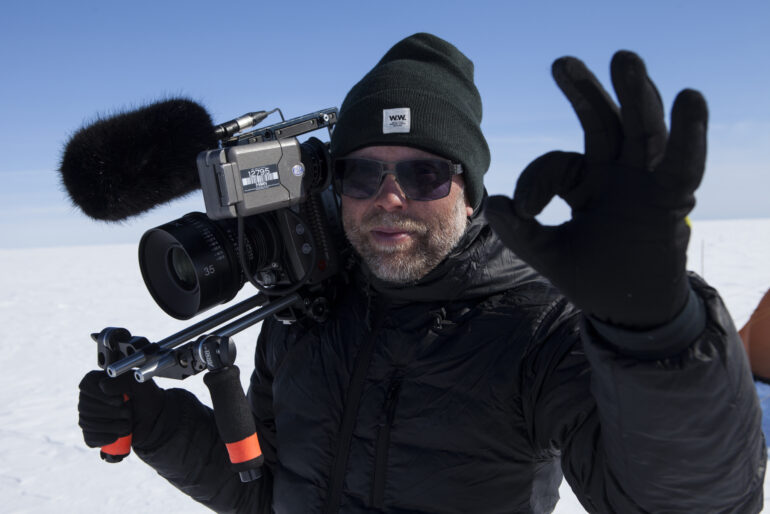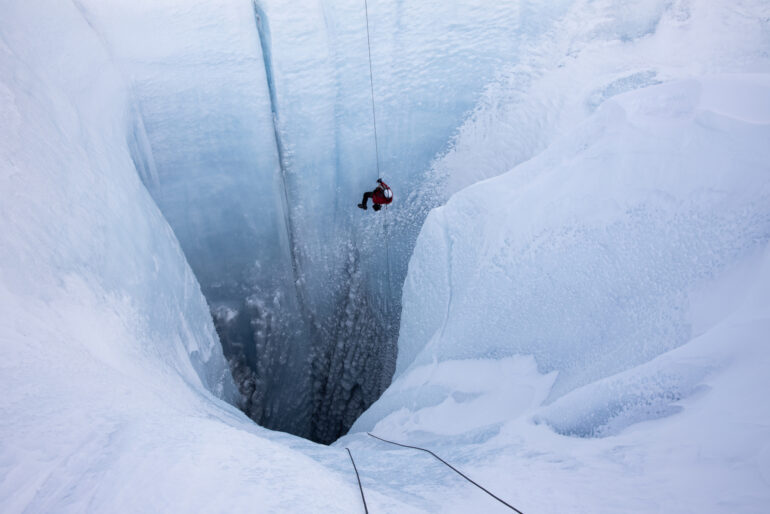WRITTEN BY: Annika Pham
The breathtaking and urgent Danish documentary about climate change is kickstarting Copenhagen’s major documentary festival March 21.
Into the Ice is the first feature length film by Lars Ostenfeld, seasoned science and nature documentary filmmaker, behind several episodes of DR’s series Wild, Wonderful Denmark, and Live from Space among others.
The director takes us in an awe-inspiring cinematic adventure on and into Greenland’s ice sheet, with three leading glaciologists Alan Hubbard, Dorthe Dahl-Jensen and Jason Box, each dedicated to understanding the scale of the climate crisis and its implications for the future.
Determined to make the audience almost ‘feel’ the ice to better connect with it and climate change, Ostenfeld faces extreme weather conditions with the scientists, and goes down 180 meters into one of Greenland’s giant holes in the ice sheet to collect important data.
The film is competing at CPH:DOX for the DOX:Award - main prize in the international competition - and for the Politiken:DOX Award Best Danish Documentary.
Into the Ice was produced by Malene Flindt Pedersen of Hensen & Pedersen, in co-production with Germany’s Kloos & Co, with co-financing from TV2 Denmark, SVT, NRK, NDR/ARTE, support among others from the Danish Film Institute and Nordisk Film & TV Fond. Rise & Shine handles world sales.
What does it mean for you to open CPH:DOX?
Lars Ostenfeld: It is a huge honour for different reasons. It is my first long feature documentary, but most importantly, when I discussed the idea for the film four years ago with the three glaciologists Dorthe Dahl-Jensen, Alun Hubbard and Jason Box, they asked: why another climate change movie? I said I’d like to help them tell the world about the fast melting of the ice and urgency to act. And now here we are. With our film opening CPH:DOX. I’m super proud. At the same time, I’m very nervous. And I’m not so sure if I’m more afraid of standing in front of a crowd at a premiere, or on the edge of a 180-meter meltwater hole in the ice sheet, listening to the ice moving and cracking. Perhaps the premiere is more frightening!
Unlike many films about climate change that use a lot of facts and figures, your film brings the viewer directly into the ice to experience, almost physically, the effect of climate change. How did you have the idea for this approach?
LO: When I see films with facts and figures about climate change, I find it depressing. But getting to know the people who provide the numbers gives me hope. My idea was to spend time on the ice with the scientists to show them at work, collecting the data about climate change, putting together the ‘ground truth’. It’s not a climate change film with data; it’s an adventure film about obtaining data.
How did you decide to focus on the three main protagonists: the glaciologists Alun Hubbard, Jason Box and Dorthe Dahl-Jensen?
L.O: Dorthe is a world-renowned Danish glaciologist so I knew about her, and I saw Jason in the National Geographic film Before the Flood. He actually lives in Copenhagen so I got in touch with him. Jason and Alun are friends, so I got in touch with Alun as well.
The three offer different perspectives: Dorthe goes back in time to understand the structure and dynamics of the ice streams, Alun goes inside the ice, what we call the ‘moulins’ [giant holes in the ice sheet], while Jason stays on top of the ice.
Logistically it must have been complicated to set an agenda for your expeditions on Greenland’s ice sheet, and Covid-19 hit at the same time…
L.O.: Covid definitely made things even more challenging. I was prepared to make expeditions with each of the scientists, but due to Covid, Dorthe’s expedition was cancelled for two years.
With Alun’s expedition into the ice, the window when you can actually go down into a moulin is very tight due to the danger linked to the melting of the ice. You can only go down 2-3 weeks during the autumn and spring time. We actually went twice. The first time was in 2019. Covid and weather conditions pushed the second expedition date to October 2020.
But then Konrad Steffen [world renowned climate scientist] had just died in an accident on the ice in Greenland. Everyone was shocked and that created a feeling of insecurity. Ultimately, we only went back in the moulin with Alun in the autumn 2021. We went to the same spot, but the ice looked totally different. The first time it was a big hole, going straight down 180 meters. The second time, the ice had shaped almost like stairs. It wasn’t as scary. Between the two expeditions with Alun, we started editing and the film was almost done when we went back in 2021.
How much training did you have to do before your expeditions?
LO: I trained with Claus, a military person from the Royal Danish Air Force who teaches the Sirius Patrol in Greenland - how to survive on the ice. He is the reason why I could do these expeditions under extreme circumstances. I also did a lot of indoor climbing.
What type of equipment-camera and sound recording- did you use to be able to film 180 meters deep into the ice?
LO: As I wanted people to connect with the ice and almost feel it, the image had to be outstanding. I brought a big 12 kg ARRI Amira camera, perfect for sharp contrasts as I had to film white icebergs in black water, or black holes with white ice around. The sound also is crucial if you want something abstract to get into your skin. I brought with me the sound guy Casper Haarløv all the way down, inside the moulin.
How difficult was it for you to write the script - so that the scientific explanation of ice melting and impact on global warming would be accessible to a large audience?
L.O.: I wrote a basic script, using the ‘Save the Cat’ method, popular with fiction films. I thought why not try to give an epic Hollywood feel to the film. I inserted all the fiction points of entry to the story, before setting off on the ice, then nature, reality took over, and when I came back, I combined everything in the same script and sent it to the Save the Cat experts who came back with useful feedback. That was helpful as well for the editing.
Jason and Alun who are true modern adventurers, risking their lives for the sake of human kind. How was it to hang out with those immensely knowledgeable, but also fun guys, and contribute at the same time to crucial understanding of climate change?
L.O. It was super funny to hang out with Jason and Alun. They are indeed true heroes. But you need humour when you face harsh elements. It is brutal out there. It was important to tell people - these guys are not only scientists, but human beings, collecting data for us all to survive. And we have to work together to survive. Their discovery is a piece of a puzzle to understand the ice.
SEE THE TRAILER
Jason speaks about the burden of awareness - having a scientific knowledge of the ‘disaster’ in slow motion of climate change. Is this something that you discussed at length with the various scientists and that they all share?
LO: Dorthe and Jason spoke about it. It’s a bit like the Cassandra syndrome in the Greek mythology, whereby true prophecies aren’t listened to. It is very frustrating to know things and feeling helpless.
Putting together expeditions are costly and scientists have to compete for funding. Is there a fear among scientists that after the pandemic, and now with war in Ukraine, climate change will again be pushed down the list of priorities by politicians?
LO: Yes. It is very frustrating for scientists. The longer we wait, the worse it will get. The last six years, we’ve had record melting of the ice. As Dorthe says in the film: we actually don’t know by how much the sea level will rise in 2100! 16cm or 1m20? Climate change is simply the biggest issue for the survival of human species.
Ultimately is your message to people: every small step helps to save the planet and also listen to scientists and to nature?
L.O.: Yes. It is key to listen to the scientists - they know what is going on and what we think will happen in the future. I feel we don’t have so much time, which is why I wanted to go out there on the ice to film the glaciologists. It’s time to wake up!



